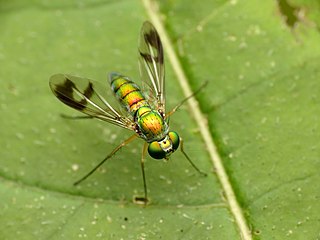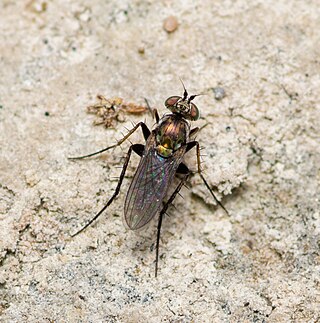Symbolia is a genus of flies in the family Dolichopodidae. It is distributed in the Neotropical realm.

Achradocera is a genus of flies in the family Dolichopodidae. It is distributed in the Nearctic and Neotropical realms as well as in Polynesia. Several Afrotropical species were also placed in the genus, but in 2018 they were transferred to Chrysotus. Achradocera was formerly considered a subgenus of Chrysotus, but was restored as a separate genus by Harold E. Robinson (1975).
Argentinia is a genus of flies in the family Dolichopodidae.
Cheiromyia is a genus of flies in the family Dolichopodidae. It is found in the Neotropical realm. It was originally named Cheirocerus by Octave Parent in 1930, but was renamed to Cheiromyia by C. E. Dyte in 1980 after it was found to be preoccupied by the catfish genus Cheirocerus. The antennae of the males bear one or more elongate projections on an enlarged postpedicel, resembling antlers. Cheiromyia is closely related to some species of Paraclius.

Condylostylus is a genus of flies in the family Dolichopodidae. It is the second largest genus in the subfamily Sciapodinae, with more 250 species included. It has a high diversity in the Neotropical realm, where 70% of the species occur.

Diaphorus is a genus of flies in the family Dolichopodidae. Lyroneurus was formerly considered a subgenus, but is now either treated as a synonym of Chrysotus or treated as a distinct genus.

Hydrophorus is a genus of flies in the family Dolichopodidae.

Medetera is a large genus of flies in the family Dolichopodidae. It includes about 350 species worldwide. The adults are commonly found resting on vertical surfaces such as tree trunks, on which they have a characteristic vertical upright stance. Because of this stance, they are sometimes known as "woodpecker flies". Medetera adults are predators of soft-bodied arthropods, while the larvae are predators of bark beetle larvae.
Notobothrus is a genus of flies in the family Dolichopodidae. It contains only one species, Notobothrus longilamellatus, which is known from the lowland Amazonian Peru and northwestern Brazilian Acre State. It was formerly placed in the subfamily Neurigoninae, but was moved to Peloropeodinae by Naglis in 2002. In 2020, the genus was excluded from the Peloropeodinae and provisionally left incertae sedis within Dolichopodidae.

Paraclius is a genus of flies in the family Dolichopodidae. It is currently considered a polyphyletic assemblage of species.
Pelastoneurus is a genus of flies in the family Dolichopodidae.

Tachytrechus is a genus of long-legged flies in the family Dolichopodidae.

Thinophilus is a genus of flies in the family Dolichopodidae. It includes about 146 described species distributed worldwide. Most species of the genus are found in coastal habitats, while a few species are found in freshwater habitats.

Hydrophorinae is a subfamily of flies in the family Dolichopodidae. Several molecular phylogenetic analyses of the family have found evidence that the subfamily in its current sense is polyphyletic.

Diaphorinae is a subfamily of flies in the family Dolichopodidae.

Peloropeodinae is a subfamily of flies in the family Dolichopodidae. In some classifications, the genera of the subfamily are included in Sympycninae. According to a molecular phylogenetic analysis of the family Dolichopodidae by Germann et al. (2011), the subfamily is polyphyletic.

Sympycninae is a subfamily of flies in the family Dolichopodidae. In some classifications, this subfamily includes the genera of the subfamilies Peloropeodinae and Xanthochlorinae.










